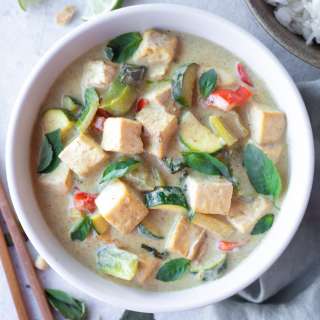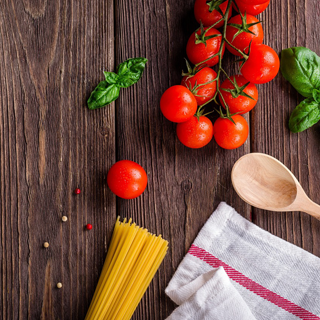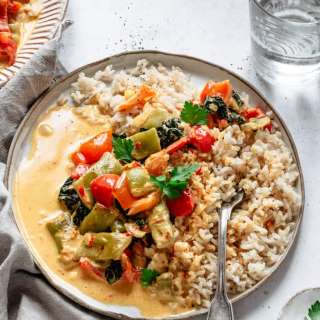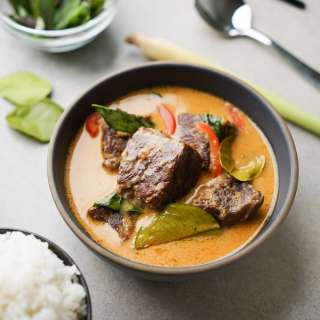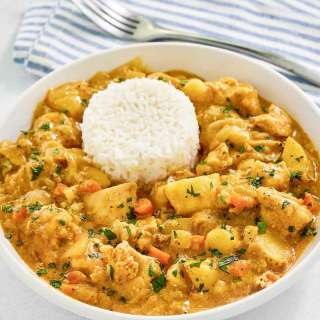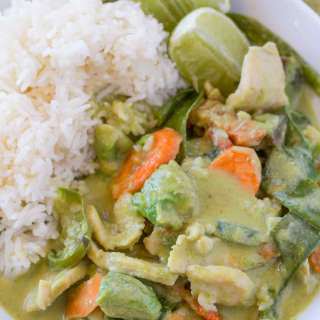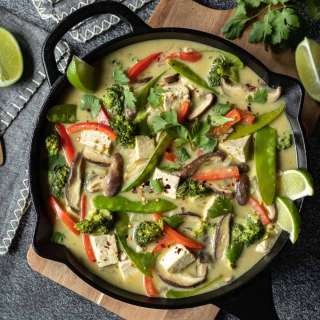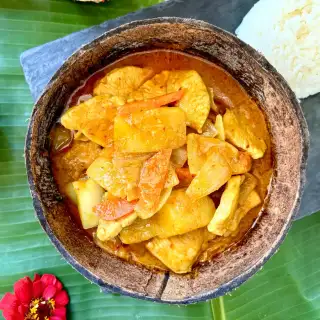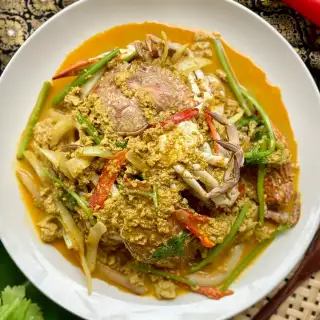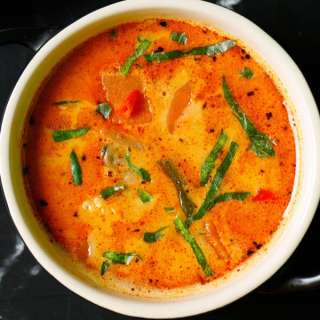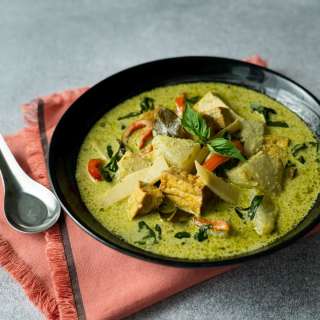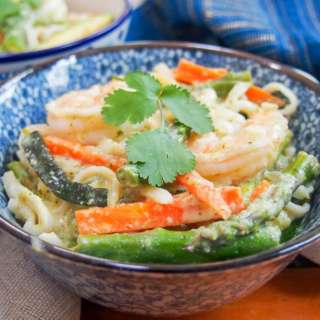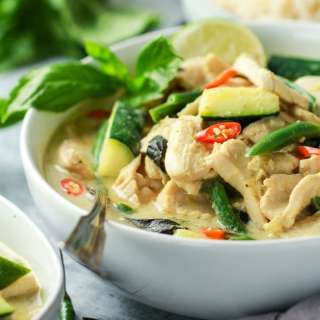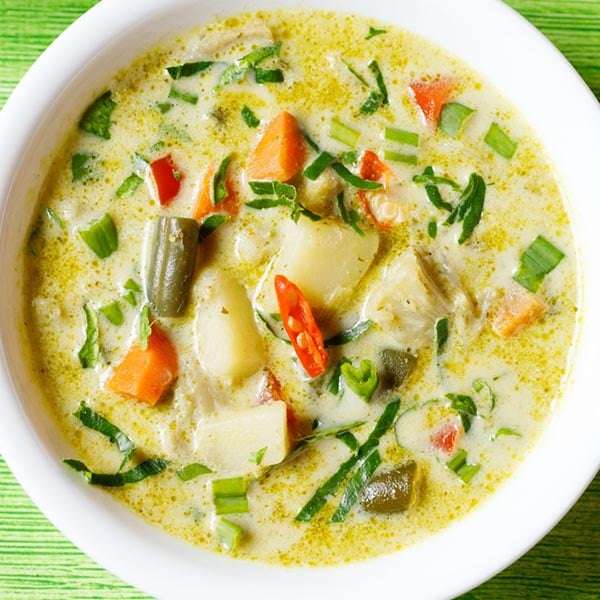
Easy Thai Green Curry with Vegetables
User Reviews
5.0
57 reviews
Excellent
-
Prep Time
15 mins
-
Cook Time
15 mins
-
Total Time
40 mins
-
Servings
4
-
Calories
254 kcal
-
Course
Main Course
-
Cuisine
Thai, International

Easy Thai Green Curry with Vegetables
Report
This Thai Green Curry recipe is made with homemade Thai Green Curry paste that can be easily customized with your favorite veggies. Spicy hot and wonderfully saucy this Thai Green Curry is delicious to enjoy over rice for a satisfying plant-based meal.
Share:
Ingredients
For Green Curry Paste
- 2 to 3 Thai chillies red colored and small-sized or 2 to 3 bird's eye chillies
- 1 green chilli or 1 teaspoon chopped green chillies
- 1 inch galangal - peeled and chopped (substitute is ginger)
- 2 to 3 garlic cloves - small-sized, peeled and chopped
- ¼ cup chopped shallots or pearl onions or onions
- ½ cup Coriander leaves (cilantro)
- 2 to 3 kaffir lime leaves - medium-sized or 4 to 5 small kaffir lime leaves
- 2 lemon grass stalks - chopped
- 2 teaspoon coriander seeds
- 1 teaspoon cumin seeds
- 1 teaspoon soy sauce - naturally brewed
- ¼ teaspoon lemon zest (grated rind of lemon), optional
- 3 tablespoons coconut milk - optional
For Thai green curry
- 2 tablespoons coconut oil or sesame oil
- 2 cups water
- 1 cup Coconut Milk (Thick) - fresh homemade or canned
- sea salt or regular salt, as required
- 2 tablespoons Thai basil leaves - chopped
Vegetables
- ¼ cup chopped french beans
- ¼ to ⅓ cup chopped bell pepper or capsicum – add any colored bell pepper
- ⅓ cup chopped baby corn
- ⅓ to ½ cup chopped carrots
- ½ cup chopped potatoes
- ½ cup chopped button mushrooms
- 1 cup chopped cauliflower or broccoli florets
- 7 to 8 Thai pea eggplant (turkey berry), optional
Instructions
Making Thai green curry paste
- Take the following chopped ingredients in a mixer-grinder jar or a small blender - thai red chilies, green chili, coriander leaves, soy sauce, shallots, galangal, lemon grass, kaffir lime leaves, coriander seeds, cumin seeds and lemon zest.
- Grind these ingredients to a semi-fine or fine paste without adding water.
- If the mixture is too dry and not getting ground, then add a few tablespoons of water and grind the curry paste ingredients. You could also grind it with some coconut milk instead of soy sauce. I won't recommend grinding the paste in a mortar and pestle as its too much of hand work .
- Grind to a semi-fine or fine paste. The curry paste made with this recipe is perfect for the this thai curry recipe.
Making thai green curry
- In a pan, heat coconut oil or sesame oil. Gently heat the oil on a medium-low heat.
- Add the green curry paste. Sauté the paste for 1 minute on low to medium-low heat.
- Add all the chopped mix vegetables. You can add your choice of veggies.
- Add 2 cups of water and mix well.
- Cover and cook till the veggies are almost done. But don't overcook the veggies.
- Add the thick coconut milk and mix it thoroughly.
- Also add salt as required. Mix again very well.
- Bring the entire curry to a gentle simmer on a low to medium-low heat. Lastly add some chopped Thai basil leaves. Stir to mix and switch off heat.
- Serve the Thai Green Curry hot with steamed jasmine rice or basmati rice. While serving garnish the green curry with some chopped spring onion greens or Thai basil or a few sliced Thai red chillies.
Notes
- Spices and Herbs: The taste and flavor of an authentic Thai Green Curry comes from using the special and unique Thai herbs and spices. If you cannot source these, there are some everyday herbs and spices that you can include, but the taste and flavor of the curry changes and is not quite like the traditionally made Thai red curry.
- Galangal: you can add ginger instead Kaffir lime leaves: add some more lemon zest or use regular lemon or lime leaves. Thai chillies: swap with green chillies Pearl onions or shallots: use small onions instead For lemon grass: There is no substitute. But you can use lemon zest, but note that it will not have the same vibrant flavor as traditional lemon grass. Cilantro: Instead of cilantro leaves, you can also blend or grind in some coriander roots (cilantro roots) or stems to add a bit of fresh flavor. Thai Basil: You could swap Thai basil with the Italian basil. Even though both have different flavor profiles, but Italian basil can be used instead.
- Galangal: you can add ginger instead
- Kaffir lime leaves: add some more lemon zest or use regular lemon or lime leaves.
- Thai chillies: swap with green chillies
- Pearl onions or shallots: use small onions instead
- For lemon grass: There is no substitute. But you can use lemon zest, but note that it will not have the same vibrant flavor as traditional lemon grass.
- Cilantro: Instead of cilantro leaves, you can also blend or grind in some coriander roots (cilantro roots) or stems to add a bit of fresh flavor.
- Thai Basil: You could swap Thai basil with the Italian basil. Even though both have different flavor profiles, but Italian basil can be used instead.
- Vegetables: Add your favorite veggies. I like to include carrots, green beans, baby corn, bell pepper, cauliflower and potatoes. But feel free to use other veggies like broccoli, zucchini, mushrooms, etc or the ones which you like.
- Soy Sauce: Instead of soy sauce, you can use tamari or coconut aminos or Bragg's liquid aminos.
- More Protein: Add some healthy plant based protein to the curry by including cubes or chunks of extra firm tofu.
- Consistency: Adjust the consistency of the curry to your liking. I prefer slightly thin curries, so I add a bit more water. Use less and your curry will be thicker.
- Liquids: Easily add homemade vegetable broth instead of water. For a thicker consistency add a bit of coconut milk.
- Spiciness: If you like very spicy food, you can increase the heat by adding a few more chilies. For a slightly milder use only 1 small Thai green chili or 1 bird's eye chilli.
- Scaling: You can double or triple only the green curry paste recipe to make a large batch of green curry paste. Store unused portions in an airtight container and keep in the freezer for up to 3 months.
Nutrition Information
Show Details
Calories
254kcal
(13%)
Carbohydrates
20g
(7%)
Protein
5g
(10%)
Fat
19g
(29%)
Saturated Fat
11g
(55%)
Polyunsaturated Fat
3g
Monounsaturated Fat
4g
Sodium
447mg
(19%)
Potassium
562mg
(16%)
Fiber
4g
(16%)
Sugar
4g
(8%)
Vitamin A
2119IU
(42%)
Vitamin B1 (Thiamine)
0.1mg
Vitamin B2 (Riboflavin)
0.1mg
Vitamin B3 (Niacin)
2mg
Vitamin B6
0.3mg
Vitamin B12
0.01µg
Vitamin C
35mg
(39%)
Vitamin D
0.03µg
Vitamin E
0.4mg
Vitamin K
20µg
Calcium
59mg
(6%)
Vitamin B9 (Folate)
47µg
Iron
4mg
(22%)
Magnesium
58mg
Phosphorus
137mg
Zinc
1mg
Nutrition Facts
Serving: 4Serving
Amount Per Serving
Calories 254 kcal
% Daily Value*
| Calories | 254kcal | 13% |
| Carbohydrates | 20g | 7% |
| Protein | 5g | 10% |
| Fat | 19g | 29% |
| Saturated Fat | 11g | 55% |
| Polyunsaturated Fat | 3g | 18% |
| Monounsaturated Fat | 4g | 20% |
| Sodium | 447mg | 19% |
| Potassium | 562mg | 12% |
| Fiber | 4g | 16% |
| Sugar | 4g | 8% |
| Vitamin A | 2119IU | 42% |
| Vitamin B1 (Thiamine) | 0.1mg | |
| Vitamin B2 (Riboflavin) | 0.1mg | |
| Vitamin B3 (Niacin) | 2mg | |
| Vitamin B6 | 0.3mg | |
| Vitamin B12 | 0.01µg | 0% |
| Vitamin C | 35mg | 39% |
| Vitamin D | 0.03µg | 0% |
| Vitamin E | 0.4mg | |
| Vitamin K | 20µg | |
| Calcium | 59mg | 6% |
| Vitamin B9 (Folate) | 47µg | |
| Iron | 4mg | 22% |
| Magnesium | 58mg | 15% |
| Phosphorus | 137mg | |
| Zinc | 1mg |
* Percent Daily Values are based on a 2,000 calorie diet.
Genuine Reviews
User Reviews
Overall Rating
5.0
57 reviews
Excellent
Other Recipes
